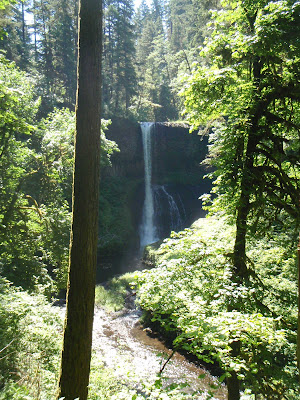The first part of the series is located here: http://beavercountryramblings.blogspot.com/2012/12/the-story-of-silver-falls-state-park.html
THE TEN FALLS
South Falls
South Falls, you can walk behind the waterfall and see the sedimentary rock that makes up the Vantage Interbed. If you look up into the small caves behind the waterfall, you can see multi-colored erosional chimneys—the result of mineral deposition as water slowly erodes ancient tree casts. Nearby is an ADA accessible viewing area for those who cannot walk down the steep slope to the bottom of the canyon. Also nearby is a small waterfall known as Frenchie Falls. At 177 feet high, this waterfall is the highest single-drop waterfall in the park. It is also the first waterfall that formed part of the original park.
Lower South Falls
The
Lower South Falls is a second waterfall that you can walk behind. At 93 feet
high, this waterfall is the sixth highest waterfall in the park. During winter
and early spring, this waterfall forms a solid wall of water.
Lower
North Falls
At only 30 feet high, Lower North Falls is the second smallest of the main waterfalls. Unlike those on the South Fork, this waterfall cascades over only one lava flow. In late October, the colors of the vine maples accentuate the white ribbons of water.
Double Falls
At 178 feet
high, Double Falls is the highest waterfall in the park. Located on Hullt
Creek, it is a short hike off of the main Canyon Trail. It gets its name as
being the only waterfall in the park that drops twice. (The first drop is at
the top of the photo, just right of center.)
Drake Falls
At 27 feet high, Drake Falls is the smallest waterfall on the Trail of Ten Falls. It was named after Silverton Photographer June Drake.
Middle North Falls
At
106 feet high, the Middle North Falls is the fifth tallest waterfall in Silver
Falls State Park. This waterfall has three things in common with the Lower
South Falls: there is a trail that goes behind it, the top two lava flows are
the same at each waterfall, and both of them become walls of water in winter
and late spring.
Winter Falls
While Winter
Falls is the fourth largest waterfall at Silver Falls State Park with a height
of 134 feet, it becomes just a trickle in late summer. To see this one at its
peak, the best time to view it is in winter and early spring. The name of this
waterfall comes from the fact that its water comes from snowmelt and rain.
Twin Falls
At 31 feet
high, Twin Falls is the third smallest waterfall in Silver Falls State Park.
This is one of only two places where you can see gouge marks in the rock due to
a large volume of water that flowed through at one time. The other place that
shows gouge marks is just upstream from the top of North Falls. Due to these
gouge marks, the stream has been split into three as it cascades down toward
the pool below.
North Falls
As the third
largest waterfall in Silver Falls State Park at 136 feet, North Falls puts on
the greatest show in the winter and early spring when its thunderous roar can
be heard over a quarter mile away at the North Falls Viewpoint. The cavern
behind the waterfall contains the casts of ancient trees in the ceiling. At the
base of the waterfall, car-sized boulders litter the stream bed, and a few
hundred feet downstream are boulders as large as a bedroom. Each one of these
boulders broke off from the ledge the water flows over.
Upper North Falls
Of all the
waterfalls on the Trail of Ten Falls, the Upper North Falls is the only one
that is not surrounded by a deep canyon. At 65 feet high, it is the fourth
smallest waterfall in the park.










No comments:
Post a Comment